牛津译林版(2019)必修 第三册Unit 3 The world online Integrated skills (1)—Listening and Watching课件(共22张PPT)
文档属性
| 名称 | 牛津译林版(2019)必修 第三册Unit 3 The world online Integrated skills (1)—Listening and Watching课件(共22张PPT) | 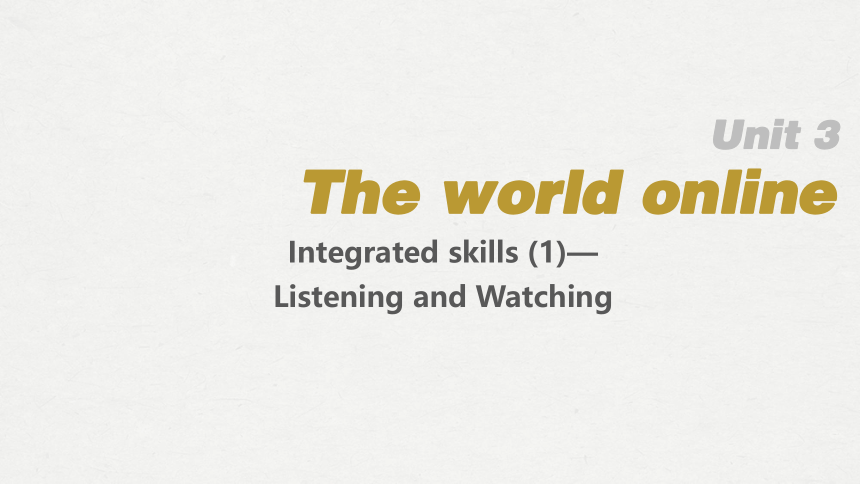 | |
| 格式 | pptx | ||
| 文件大小 | 48.7MB | ||
| 资源类型 | 教案 | ||
| 版本资源 | 牛津译林版(2019) | ||
| 科目 | 英语 | ||
| 更新时间 | 2024-04-02 10:44:50 | ||
图片预览

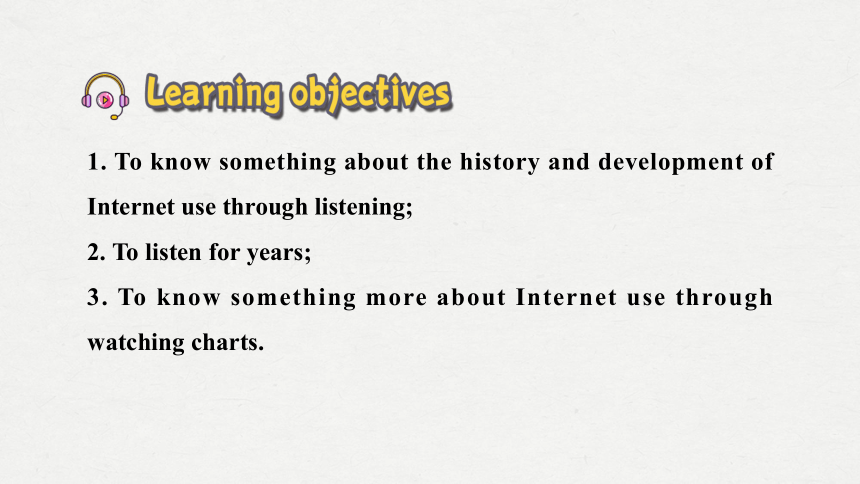
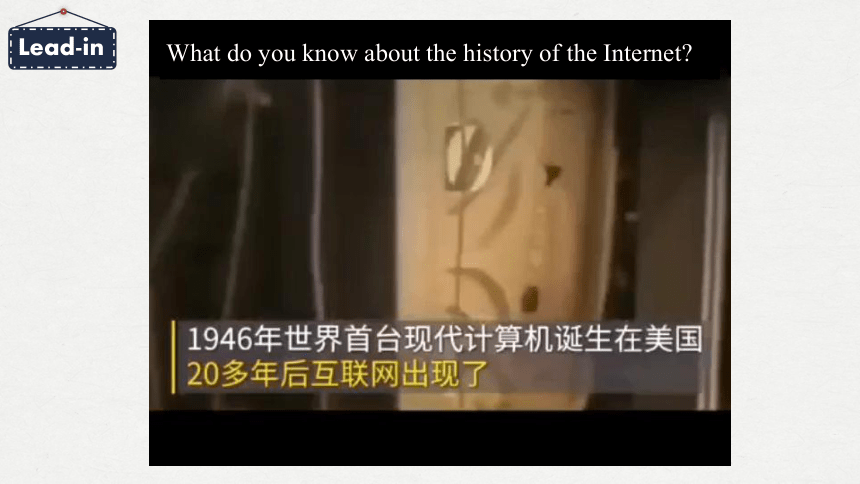
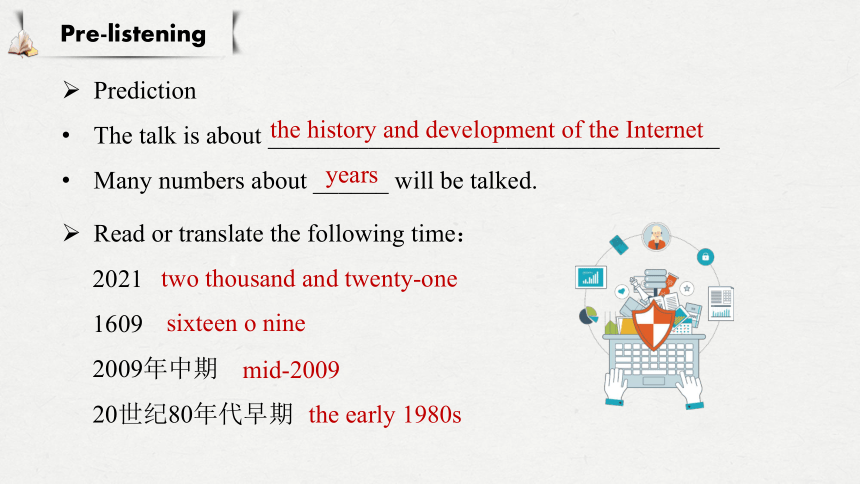
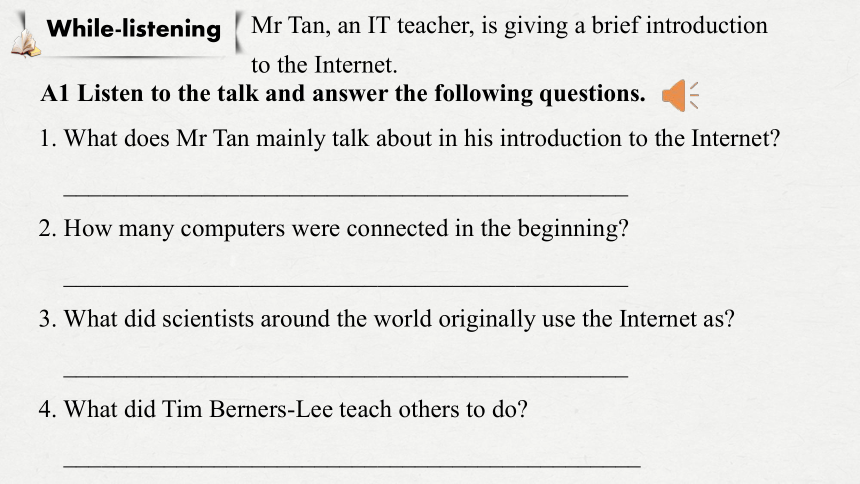
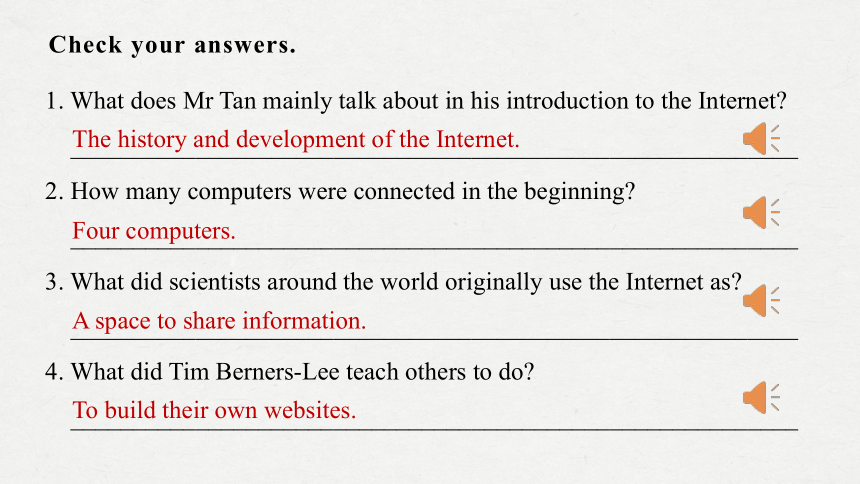
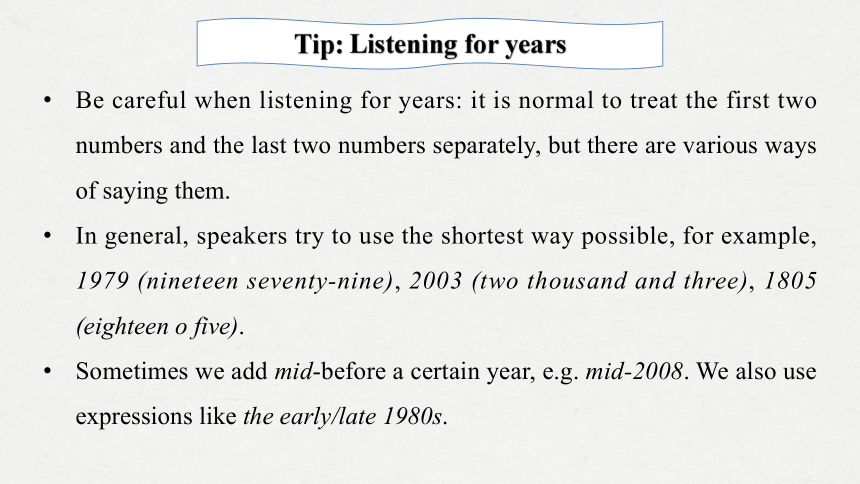
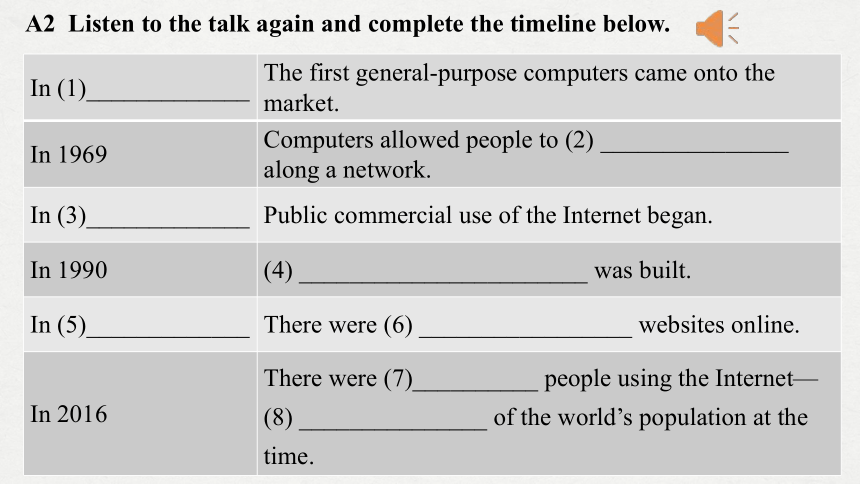
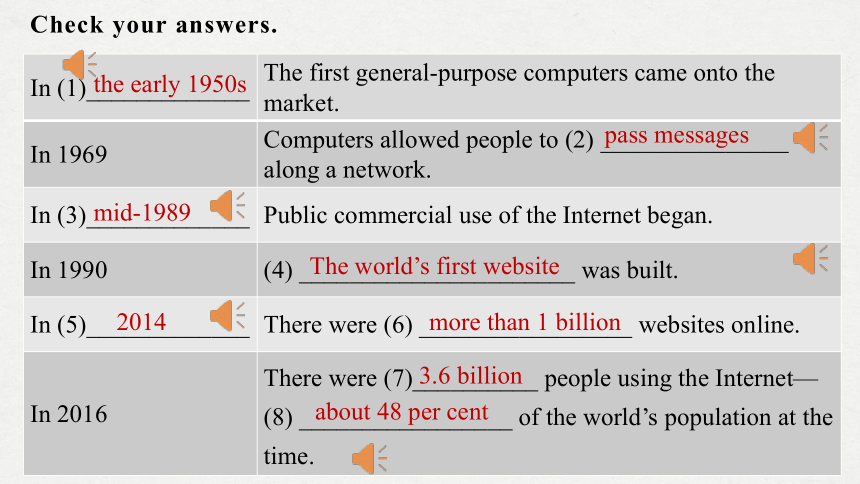
文档简介
(共22张PPT)
Unit 3
The world online
Integrated skills (1)—
Listening and Watching
1. To know something about the history and development of Internet use through listening;
2. To listen for years;
3. To know something more about Internet use through watching charts.
Lead-in
What do you know about the history of the Internet
Pre-listening
Prediction
The talk is about ____________________________________
Many numbers about ______ will be talked.
the history and development of the Internet
years
Read or translate the following time:
2021
1609
2009年中期
20世纪80年代早期
two thousand and twenty-one
sixteen o nine
mid-2009
the early 1980s
1. What does Mr Tan mainly talk about in his introduction to the Internet
_____________________________________________
2. How many computers were connected in the beginning
_____________________________________________
3. What did scientists around the world originally use the Internet as
_____________________________________________
4. What did Tim Berners-Lee teach others to do
______________________________________________
A1 Listen to the talk and answer the following questions.
Mr Tan, an IT teacher, is giving a brief introduction to the Internet.
While-listening
1. What does Mr Tan mainly talk about in his introduction to the Internet
__________________________________________________________
2. How many computers were connected in the beginning
__________________________________________________________
3. What did scientists around the world originally use the Internet as
__________________________________________________________
4. What did Tim Berners-Lee teach others to do
__________________________________________________________
The history and development of the Internet.
Four computers.
A space to share information.
To build their own websites.
Check your answers.
Be careful when listening for years: it is normal to treat the first two numbers and the last two numbers separately, but there are various ways of saying them.
In general, speakers try to use the shortest way possible, for example, 1979 (nineteen seventy-nine), 2003 (two thousand and three), 1805 (eighteen o five).
Sometimes we add mid-before a certain year, e.g. mid-2008. We also use expressions like the early/late 1980s.
Tip: Listening for years
In (1)_____________ The first general-purpose computers came onto the market.
In 1969 Computers allowed people to (2) _______________ along a network.
In (3)_____________ Public commercial use of the Internet began.
In 1990 (4) _______________________ was built.
In (5)_____________ There were (6) _________________ websites online.
In 2016 There were (7)__________ people using the Internet—(8) _______________ of the world’s population at the time.
A2 Listen to the talk again and complete the timeline below.
In (1)_____________ The first general-purpose computers came onto the market.
In 1969 Computers allowed people to (2) _______________ along a network.
In (3)_____________ Public commercial use of the Internet began.
In 1990 (4) ______________________ was built.
In (5)_____________ There were (6) _________________ websites online.
In 2016 There were (7)__________ people using the Internet—(8) _________________ of the world’s population at the time.
the early 1950s
pass messages
mid-1989
The world’s first website
2014
more than 1 billion
3.6 billion
about 48 per cent
Check your answers.
Tapescript
Good morning, class. Today I’m going to talk about the Internet. I’m sure all of you use the Internet, but what do you know about it Now let me tell you about its history and development.
The first general-purpose computers came onto the market in the early 1950s, but it was only in 1969 that scientists invented a way for computers to communicate with each other. This meant that computers allowed people to pass messages along a network and talk to each other. To start with, only four computers were connected and the network was for military use. Public commercial use of the Internet began in mid-1989.
One of the main applications of the Internet is the World Wide Web. Pages on the World Wide Web are called websites and can be accessed through the Internet. They were originally used as a space for scientists around the world to share information. The world’s first website was built in 1990 by Tim Berners-Lee, a British scientist. He then taught others how to build their own websites, allowing the Internet to grow.
Within 24 years, there were more than 1 billion websites online. Two years later, in 2016, 3.6 billion people were using the Internet—about 48 per cent of the world’s population at the time. And increasingly, people are using their phones to access the Internet. The future is definitely online and it’s definitely mobile.
Watching
1. How do you usually access the Internet, using a mobile phone
or other devices
2. What do you often do on the Internet
By using a mobile device, such as a smartphone and a tablet.
I often play online games, send emails, text instant messages, search for information, download learning resources, do online shopping and make online payments on the Internet.
Lead-in
Tip
Viewing charts
There are different types of charts to show information. Bar charts are often used to show how something changes over time or to compare different things. Pie charts are used to show percentages. Line charts are often used to show trends. To understand a chart, it is important to read the title and captions.
Mr Tan also shows the students some charts about Internet use.
Activity 1 Read for some details
1. What types of chart are they
pie chart
bar chart
bar chart
Chart 1
Chart 2
Chart 3
2. According to the first chart, which use of the Internet has increased the most during the last five years
3. What change can you see from the two pie charts
4. In the last chart, what change do you notice in the Internet users above 59
More and more people have been going online using mobile devices.
Travel booking.
An increasing percentage of people above 59 use the Internet now.
Activity 2 Read for some good sentences
Useful expressions in describing charts
As can be seen/conveyed/illustrated/reflected from the chart,...
There is/has been a rise/an increase/a drop/a decrease of...per cent.
The number has risen/increased/dropped/decreased from...to...
The figure has gone up/gone down/fallen by...per cent.
...times as many people went online using mobile devices.
...the figure/number/percentage remains/stays the same/unchanged.
...has remained/stayed the same/unchanged.
As can be seen/conveyed/illustrated/reflected from the bar chart, over the past five years, the number of people using the Internet for news/search engines/instant messaging/shopping/payment/travel booking has risen/increased from 65% to 82%, from 92% to 98%, from 80% to 90%, from about 39% to 61%, from about 31% to 62%, from about 8% to 40% respectively.
Chart 1
Have a try
As can be reflected from the pie charts, over the past five years, the percentage of users who access the Internet using mobile devices have risen/increased from 69% to 95%, while the percentage of users who access the Internet without using mobile devices has dropped/decreased from 31% to 5%.
Chart 2
As can be conveyed from the chart, over the past five years, the percentage of Internet users has been increasing in most age groups, but the 20-39 age group has decreased by about 10%.
Chart 3
Activity 3 Discussion
What changes will take place in the future
Activity 4 Discussion
When we write a report, we can use the following outline.
Homework
Finish the exercises that are given today.
Unit 3
The world online
Integrated skills (1)—
Listening and Watching
1. To know something about the history and development of Internet use through listening;
2. To listen for years;
3. To know something more about Internet use through watching charts.
Lead-in
What do you know about the history of the Internet
Pre-listening
Prediction
The talk is about ____________________________________
Many numbers about ______ will be talked.
the history and development of the Internet
years
Read or translate the following time:
2021
1609
2009年中期
20世纪80年代早期
two thousand and twenty-one
sixteen o nine
mid-2009
the early 1980s
1. What does Mr Tan mainly talk about in his introduction to the Internet
_____________________________________________
2. How many computers were connected in the beginning
_____________________________________________
3. What did scientists around the world originally use the Internet as
_____________________________________________
4. What did Tim Berners-Lee teach others to do
______________________________________________
A1 Listen to the talk and answer the following questions.
Mr Tan, an IT teacher, is giving a brief introduction to the Internet.
While-listening
1. What does Mr Tan mainly talk about in his introduction to the Internet
__________________________________________________________
2. How many computers were connected in the beginning
__________________________________________________________
3. What did scientists around the world originally use the Internet as
__________________________________________________________
4. What did Tim Berners-Lee teach others to do
__________________________________________________________
The history and development of the Internet.
Four computers.
A space to share information.
To build their own websites.
Check your answers.
Be careful when listening for years: it is normal to treat the first two numbers and the last two numbers separately, but there are various ways of saying them.
In general, speakers try to use the shortest way possible, for example, 1979 (nineteen seventy-nine), 2003 (two thousand and three), 1805 (eighteen o five).
Sometimes we add mid-before a certain year, e.g. mid-2008. We also use expressions like the early/late 1980s.
Tip: Listening for years
In (1)_____________ The first general-purpose computers came onto the market.
In 1969 Computers allowed people to (2) _______________ along a network.
In (3)_____________ Public commercial use of the Internet began.
In 1990 (4) _______________________ was built.
In (5)_____________ There were (6) _________________ websites online.
In 2016 There were (7)__________ people using the Internet—(8) _______________ of the world’s population at the time.
A2 Listen to the talk again and complete the timeline below.
In (1)_____________ The first general-purpose computers came onto the market.
In 1969 Computers allowed people to (2) _______________ along a network.
In (3)_____________ Public commercial use of the Internet began.
In 1990 (4) ______________________ was built.
In (5)_____________ There were (6) _________________ websites online.
In 2016 There were (7)__________ people using the Internet—(8) _________________ of the world’s population at the time.
the early 1950s
pass messages
mid-1989
The world’s first website
2014
more than 1 billion
3.6 billion
about 48 per cent
Check your answers.
Tapescript
Good morning, class. Today I’m going to talk about the Internet. I’m sure all of you use the Internet, but what do you know about it Now let me tell you about its history and development.
The first general-purpose computers came onto the market in the early 1950s, but it was only in 1969 that scientists invented a way for computers to communicate with each other. This meant that computers allowed people to pass messages along a network and talk to each other. To start with, only four computers were connected and the network was for military use. Public commercial use of the Internet began in mid-1989.
One of the main applications of the Internet is the World Wide Web. Pages on the World Wide Web are called websites and can be accessed through the Internet. They were originally used as a space for scientists around the world to share information. The world’s first website was built in 1990 by Tim Berners-Lee, a British scientist. He then taught others how to build their own websites, allowing the Internet to grow.
Within 24 years, there were more than 1 billion websites online. Two years later, in 2016, 3.6 billion people were using the Internet—about 48 per cent of the world’s population at the time. And increasingly, people are using their phones to access the Internet. The future is definitely online and it’s definitely mobile.
Watching
1. How do you usually access the Internet, using a mobile phone
or other devices
2. What do you often do on the Internet
By using a mobile device, such as a smartphone and a tablet.
I often play online games, send emails, text instant messages, search for information, download learning resources, do online shopping and make online payments on the Internet.
Lead-in
Tip
Viewing charts
There are different types of charts to show information. Bar charts are often used to show how something changes over time or to compare different things. Pie charts are used to show percentages. Line charts are often used to show trends. To understand a chart, it is important to read the title and captions.
Mr Tan also shows the students some charts about Internet use.
Activity 1 Read for some details
1. What types of chart are they
pie chart
bar chart
bar chart
Chart 1
Chart 2
Chart 3
2. According to the first chart, which use of the Internet has increased the most during the last five years
3. What change can you see from the two pie charts
4. In the last chart, what change do you notice in the Internet users above 59
More and more people have been going online using mobile devices.
Travel booking.
An increasing percentage of people above 59 use the Internet now.
Activity 2 Read for some good sentences
Useful expressions in describing charts
As can be seen/conveyed/illustrated/reflected from the chart,...
There is/has been a rise/an increase/a drop/a decrease of...per cent.
The number has risen/increased/dropped/decreased from...to...
The figure has gone up/gone down/fallen by...per cent.
...times as many people went online using mobile devices.
...the figure/number/percentage remains/stays the same/unchanged.
...has remained/stayed the same/unchanged.
As can be seen/conveyed/illustrated/reflected from the bar chart, over the past five years, the number of people using the Internet for news/search engines/instant messaging/shopping/payment/travel booking has risen/increased from 65% to 82%, from 92% to 98%, from 80% to 90%, from about 39% to 61%, from about 31% to 62%, from about 8% to 40% respectively.
Chart 1
Have a try
As can be reflected from the pie charts, over the past five years, the percentage of users who access the Internet using mobile devices have risen/increased from 69% to 95%, while the percentage of users who access the Internet without using mobile devices has dropped/decreased from 31% to 5%.
Chart 2
As can be conveyed from the chart, over the past five years, the percentage of Internet users has been increasing in most age groups, but the 20-39 age group has decreased by about 10%.
Chart 3
Activity 3 Discussion
What changes will take place in the future
Activity 4 Discussion
When we write a report, we can use the following outline.
Homework
Finish the exercises that are given today.
同课章节目录
- Unit 1 Nature in the balance
- Welcome to the unit
- Reading
- Grammar and usage
- Integrated skills
- Extended reading
- Project
- Unit 2 Natural disasters
- Welcome to the unit
- Reading
- Grammar and usage
- Integrated skills
- Extended reading
- Project
- Unit 3 The world online
- Welcome to the unit
- Reading
- Grammar and usage
- Integrated skills
- Extended reading
- Project
- Unit 4 Scientists who changed the world
- Welcome to the unit
- Reading
- Grammar and usage
- Integrated skills
- Extended reading
- Project
